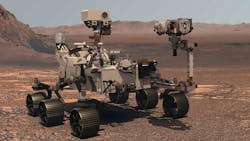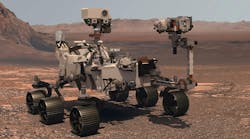Semiconductors: The Unsung Heroes in Space Exploration
What you’ll learn:
- Semiconductor chips have played a critical role in space exploration for over 60 years.
- The harsh environment of space requires special processing and testing of space-mission semiconductor components.
- Newer low-Earth applications of semiconductors use a mix of space-qualified and commercial devices to reduce cost and increase capability.
Semiconductor components help ensure reliability and performance in space's extreme environment. Over the past 60 years, microchips have played a pivotal role in more than 100 space missions, driving the success of some of the most historic milestones in space exploration. From the first successful U.S. space mission in 1958 to the ongoing Artemis missions, these components (see table) have consistently proven their value.
The Crucial Role of Semiconductor Components in Space Missions
Since the launch of the first US satellite, Explorer 1 onboard the Jupiter-C missile, semiconductors have had to demonstrate space qualifications, meeting stringent radiation and reliability standards while in outer space.
Semiconductor components in space missions began with frequency-control devices. Frequency control like quartz crystal oscillators, voltage-controlled SAW oscillators (VCSOs), or atomic clocks are critical in space-mission electronics, as it ensures the accurate transmission and reception of signals, maintaining communication stability, data integrity, and synchronization of systems.
These components were vital to the success of the first U.S. space mission in 1958 and laid the foundation for a legacy of reliability in space. The Apollo 11 lunar landing in 1969, one of humanity's greatest achievements, also relied on these technologies. Microchip provided critical communication support within the Apollo 11 Lunar Module (LM) on the surface of the moon as well as the critical logic components (see figure) used for the onboard guidance computer.
Rubidium, SAW, and quartz oscillators support more military communications, satellite ground stations, and test-and-measurement applications than any other precision frequency references in the world.
The Voyager 1 mission, now the farthest human-made object from Earth, further showcased the unmatched performance of semiconductors in space. Voyager 1’s electronics featured a mix of TTL and CMOS logic ICs, analog components, memory chips, and custom semiconductors designed to handle the challenges of deep space.
Voyager 1's main computer used a custom-built central processing unit (CPU) called the SPS-8, which was designed for the spacecraft by NASA. TTL logic chips were a popular type of digital integrated circuit at the time; now most semiconductor ICs are CMOS-based.
>>Download the PDF of this article
In more recent years, semiconductor technologies have been central to Mars exploration. The Curiosity and Perseverance rovers, which have provided invaluable insights into the Red Planet, depend on these components to operate in Mars' harsh environment.
The Mars rover, specifically the Perseverance rover, contains several components from Microchip Technology. These include a SPARC processor used for various control systems and data-processing tasks, as well as power-management ICs (PMICs) that are crucial for efficiently managing the power supply to different parts of the rover. All of these are radiation-hardened (rad-hard) components, thus ensuring the electronics can withstand the harsh space environment. Such components are essential for the rover's operation and help it perform scientific tasks on Mars.
For lunar exploration, the Chandrayaan-3 mission, India's third lunar exploration mission, utilized several semiconductor components. These components—e.g., radiation-tolerant (RT) antifuse FPGAs—are crucial for the mission's success, enabling communication, navigation, and scientific experiments on the lunar surface.
The ongoing Artemis missions, which aim to return humans to the Moon and eventually send them to Mars, also rely on the proven performance and reliability of semiconductor technologies.
The Importance of Reliability and Performance in Space Programs
In the harsh environment of space, reliability and performance aren’t just important—they’re critical. Semiconductor components lie at the heart of modern space missions, powering everything from satellites and rovers to communication systems and space stations.
Given the extreme conditions of space—unforgiving temperatures, intense radiation, and the vacuum of space—components must perform flawlessly for extended periods. Even the smallest failure in a semiconductor could lead to mission failure, which highlights the significance of selecting highly reliable components.
The Challenge of Radiation in Space
Space is filled with high levels of radiation, which can be devastating to electronic components. Radiation can degrade materials, cause electrical failures, and corrupt the data being transmitted. For example, the solar radiation environment outside Earth's protective atmosphere can expose components to energetic particles that cause single-event upsets (SEUs) or total radiation dose damage.
To combat these challenges, advanced radiation-hardening techniques include the use of specialized materials like radiation-resistant semiconductors. These design modifications reduce vulnerability to radiation. For instance, space-grade microprocessors used in onboard computers are often radiation-hardened by design (RHBD) so that failure doesn’t bring down the entire system.
Rugged Testing to Simulate Space Conditions
In addition to radiation hardening, companies with a legacy in space missions have pioneered rigorous testing and qualification processes that ensure the reliability and performance of their components. These tests go far beyond normal manufacturing quality control.
Space-grade semiconductors undergo extensive thermal-cycling tests, which simulate the wide temperature variations in space—from the intense heat of the Sun to the bitter cold of deep space. An example is NASA’s testing of components for the Mars Perseverance rover, which experienced temperature swings from −55 to 125°C, demanding components that could withstand such extremes without failure.
Components also undergo vibration testing to simulate the stresses and vibrations experienced during launch. The intense forces generated during rocket launches are unlike anything seen on Earth; therefore, semiconductor components must be able to endure these conditions without compromising their integrity. For instance, during the Apollo 11 mission, critical electronics were subjected to vibration testing to ensure that they would survive the powerful launch forces, ultimately contributing to the success of the Moon landing.
Long-Term Reliability: Examples from Space History
Space missions require components that not only work during the mission, but also continue to perform reliably over time. The Voyager 1 spacecraft, launched in 1977, is a prime example of how reliability is crucial for long-duration missions. Over 40 years in space, the spacecraft continues to communicate back to Earth thanks to the rad-hard semiconductor components that have been rigorously tested to endure extreme conditions.
Another example is the International Space Station (ISS), which relies on a multitude of semiconductor-based systems to maintain life-support systems, conduct scientific experiments, and keep communication lines open. The ISS is constantly exposed to the harsh radiation environment of space, with temperatures ranging from +121°C (facing Sun) to -157°C (in the shade), alternating every 45 or so minutes. Nevertheless, the semiconductor components onboard must function reliably day after day.
Expanding Frontier: Evolution of the Space Market
A developing trend within the space industry is increased use of commercial off-the-shelf (COTS) devices, which provide a cost-effective solution for space missions due to their immediate availability. Starlink's low-Earth-orbit (LEO) satellite network capitalizes on COTS components to reduce costs and speed up production. Many of the onboard electronics, particularly for non-critical systems, rely on these components, which are both budget-friendly and carefully selected for their reliability in space environments.
A good example is the European launcher Ariane, developed by the ESA (European Space Agency) and CNES (French Space Agency). Ariane 5 (1985) was equipped with a hardened SPARC central processor in QML grade in a hermetic package and with a 1553 network for communication between all systems within the rocket.
The most recent version, Ariane 6 (2024), now embeds a COTS processor based on Arm architecture, housed in a plastic-based package. It uses the same Ethernet for communication that’s a widely adopted industry standard, contrasting with the space/military-specific technology used in Ariane 5.
However, for high-reliability systems that must maintain strong performance in space-based communications, COTS devices need to be adapted and qualified, requiring specialized expertise. Companies seeking to enter new space markets or transition from new space to deep space are collaborating with semiconductor companies that have proven flight heritage, capable of upgrading COTS devices to meet the stringent demands of space missions.
In the short term, the future of semiconductors in space will be a blend of diverse strategies: upgrading COTS devices, leveraging our spaceflight experience with sub-QML versions of products to reduce screening requirements, lowering costs, shortening lead times, and customizing manufacturing processes to meet the unique requirements of specific mission profiles.
By combining these approaches, a robust and adaptable future for semiconductors in space is realized, while minimizing cost, complexity, and taking appropriate risks.
The Future of Semiconductor Components in Space
As the space industry continues to evolve with the rise of LEO constellations and growing space commercialization, so does the demand for reliable, high-performance semiconductor components. New space ventures require components that can meet the unique challenges, mixing high reliability, innovation, and profit-driven objectives.
>>Download the PDF of this article
About the Author

Nicolas Ganry
Senior Product Marketing Manager, Microchip Technology
Nicolas Ganry is the senior product marketing manager for Microchip Technology’s aerospace and defense business unit. He joined the company in 2012 and is based in Nantes, France. Nicolas is responsible for leading A&D microprocessors, microcontrollers, memories, and the companionships product line and is driving business development activities in Europe. He works closely with the European Space agencies and prime industry leaders of the domain.
Nicolas joined Atmel in 2012, now Microchip since 2016, bringing with him 15 years of experience in system electronics, with a focus on hardware and software development for mobile phones. He has a master’s degree in engineering from Polytech Nantes, the Graduate School of Engineering at the University of Nantes, and a master’s degree in business unit management from Audencia International Business School Nantes.



